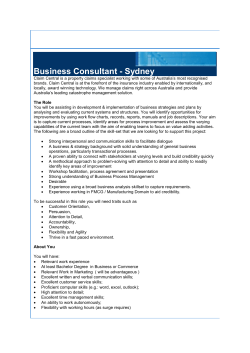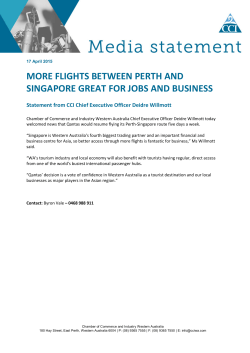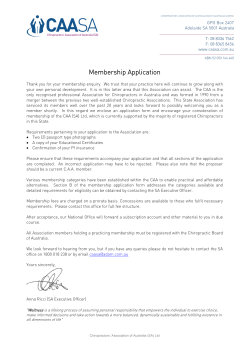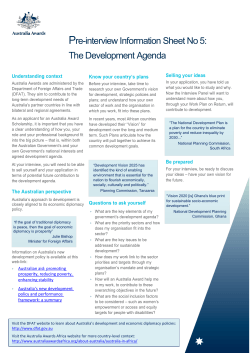
2015-16 Federal Budget NFF Commentary and
2015-16 Federal Budget NFF Commentary and Analysis 2015-16 Federal Budget | NFF Commentary and Analysis Contents Executive Summary..................................................................................................................................................................... 3 NFF Media Statement ................................................................................................................................................................. 4 Agricultural Competitiveness ................................................................................................................................................. 5 Infrastructure and Transport .................................................................................................................................................. 7 Improving Market Access and Development ................................................................................................................. 9 Tax, Public Finance and Small Business ......................................................................................................................... 10 Water and Natural Resource Management ................................................................................................................. 11 Workforce, skills and safety ................................................................................................................................................. 13 Drought Policy ........................................................................................................................................................................... 14 Appendix – NFF Budget Requests ................................................................................................................................... 15 Page 2 of 16 2015-16 Federal Budget | NFF Commentary and Analysis Executive Summary Key Indicators Economic Growth (%) Inflation (%) Unemployment (%) Surplus/Deficit ($bn) 2013-14 2014-15 2015-16 2016-17 (outcome) (estimate) (forecast) (forecast) 2.5 2.5 ↑ 2.75 3.25 3 1.75 2.5 2.5 5.9 6.25 ↑ 6.5 6.25 ($43.7) ($39.4) ↓ ($33.0) ($23.4) Overview The headlines in the lead up to the 2015 Federal Budget have centred on the social services portfolio – with changes to aged pension eligibility and childcare anchoring the reform agenda for this budget. On the revenue side, key changes include the introduction of concessional tax arrangements for small business, and attempts to reign in loopholes used by multinationals to avoid GST and company tax. The Federal Government has faced significant revenue write-downs on the back of flatter than expected wage growth (linked to unemployment) and significant falls in the iron ore price. Overall tax receipts will be $14 billion less in 2015-16 than last year’s forecast. The budget reflects a realisation that economic, fiscal and political challenges have demanded a new approach to economic management. The measures announced and the accompanying rhetoric are a noticeable departure from the 2014-15 Federal Budget and 2013 election. Overall, the budget deficit is now expected to be $39.4 billion for 2015-16 – lower than the revised forecast of $40.4 billion announced in December last year. Peak debt has continued to blow out, reaching $412 billion, rather than the $315.8bn forecast in December. The Government has stuck to its original timeframe for a return to surplus despite its deteriorating budget position, forecasting to be back in the black by 2019-20. The picture for agriculture is less dire. The overall budget for the agriculture portfolio has held reasonably steady at $2 billion, and a significant pool of funds is expected to underpin the white papers for Agricultural Competitiveness and Northern Australia, plus a package to build new dams. Budget highlights: • A tax cut for small business – 1.5% off the company tax rate and a 5% discount for unincorporated business income. • $25 million to enhance the benefit of free trade agreements. • Confirmation of drought assistance announced pre-budget. • Accelerated depreciation for small business and separate scheme for fodder, water and fencing. Page 3 of 16 2015-16 Federal Budget | NFF Commentary and Analysis NFF Media Statement Budget lays groundwork for Ag White Paper National Farmers’ Federation (NFF) President, Brent Finlay, said tonight’s Federal Budget has farmers all over Australia eagerly anticipating the release of the Agricultural Competitiveness White Paper. The Budget delivers modest gains for the farm sector through specific initiatives that will assist cash flow on farm; lower business taxes; boost bilateral trade agreement outcomes and recognise challenging seasonal conditions facing parts of the sector. Mr Finlay said the agriculture portfolio largely held its ground, with funding of around $2 billion, despite an expected decrease in the Government’s tax receipts of some $14 billion. “This recognises that the agriculture sector is a source of economic strength, linked to growing appetites for safe, clean and sustainable Aussie produce in key Asian markets,” Mr Finlay said. “The measures announced tonight on trade, tax breaks and small business measures will be welcome news for Australian farmers.” Key announcements for the agriculture sector include: - Specific measures that will allow farmers to accelerate depreciation for spending on water, fodder and fencing which will encourage investment and improve cash flow on farm. - $25 million to help Australian producers access the benefits of free trade agreements, an initiative called for by the NFF. - Small business tax cuts which will assist more than 110,000 farm businesses that have less than $2 million in cash receipts. - $83 million for pre-announced drought funding for rural communities and pest and weed control. “We hope that tonight’s budget is a preview of policies and significant funding commitments for tangible initiatives to support agricultural competitiveness and growth,” Mr Finlay said. “All eyes will now be on the Agricultural Competitiveness White Paper and the Northern Australia White Paper. Together, these policies will be the measure of this Government’s commitment to, and vision for, the success of the agriculture sector.” Ends. Page 4 of 16 2015-16 Federal Budget | NFF Commentary and Analysis Agricultural Competitiveness At a glance… As expected, the Agriculture portfolio holds few surprises, with announcements being held over to the release of the Agricultural Competitiveness White Paper. Overall funding for the Agriculture portfolio was slightly reduced to $2 billion. Funding for rural research and development has been maintained. $30 million has been allocated to attract food and agribusiness investment to Australia. Agricultural Competitiveness White Paper The Budget allocates a pool of $1.7 billion, which will be used to fund commitments under the Agricultural Competitiveness White Paper and Northern Australia White Paper (the split between these two measures is not confirmed by the budget papers). The White Paper will deliver a series of policy changes and funding commitments and is due to be released in coming months. Continued investment in research and development The budget does not propose and changes to the funding arrangements for rural research and development (aside from previously announced levy increases for bananas, honey, laying chickens and chicken meat). This means that the government will continue to contribute around $250 million to the rural R&D corporation model. In addition to the regular RDC contributions, the government will continue to roll out the $100 million Rural R&D for Profit scheme announced last year. The budget continues to forecast $30 million in research expenditure under this program for the 2015-16 financial year. The NFF has argued strongly for R&D funding to be maintained. Strengthening Australia’s ability to attract foreign investment The Government will provide $30.0 million over four years to attract major job creating investment in each of the Government’s five investment priority areas: infrastructure; tourism; resources and energy; agribusiness and food; and advanced manufacturing, services and technology. This funding will also provide for investment attraction events, detailed market research and analysis to support attracting investment, and provide additional staff dedicated to investment promotion within Australia and overseas. Tasmanian Freight Equalisation Scheme (TFES) The Government will extend the Tasmanian Freight Equalisation Scheme (TFES) from 1 January 2016 to include a subsidy at a flat rate of $700 per twenty-foot equivalent unit for exports. This is estimated to cost $202.9 million over four years. Page 5 of 16 2015-16 Federal Budget | NFF Commentary and Analysis The current scheme for domestic goods will be retained. In addition to this extension, the Government will reduce the time-frame for TFES claims from two years to six months from the time of shipment. Abolition of Government Committees The Government will reduce the number of bodies within the Agriculture portfolio by abolishing the: Aquaculture Committee; Community Consultative Committee; Industry Liaison Committee; National Decision Making and Investment Working Group; and, Statutory Fishing Rights Allocation Review Panel. Many of these committees were either inactive or internal Government mechanisms. The NFF is not concerned by their abolition. Agriculture, Forestry & Fisheries - total funding ($m) 2500 2000 1500 1000 500 0 2010-11 2011-12 2012-13 2013-14 2014-15 2015-16 Page 6 of 16 2015-16 Federal Budget | NFF Commentary and Analysis Infrastructure and Transport At a glance… ‘Stronger Communities Program’ will deliver $300,000 to every electorate for local infrastructure projects. $100 million for Beef Roads upgrades as part of the Northern Australia White Paper. $5 billion debt facility will be created to fund infrastructure in Northern Australia. Previously announced funding commitments maintained. $100 million for ‘Beef Roads’ upgrade scheme Announced last week, the Federal Government has included funding of $101.3 million to undertake targeted upgrades on beef transport routes in northern Australia. The objective of this scheme is to improve the productivity of the beef industry in Northern Australia. Project selection will be based on the CSIRO’s new logistics modelling system. This announcement forms part of the Northern Australia White Paper, due for release in coming months. Stronger Communities Program injects $45 million A new ‘Stronger Communities Program’ will deliver $45 million over the next two financial years for small capital projects in the form of $150,000 per year for two years for each electorate nationally. While the NFF supports Federal Government funding for productivity-improving local infrastructure upgrades, it is unclear how the funds will be allocated within each electorate. Overall funding could generate better productivity uplift if targeted by need rather than by electorate. Coastal Shipping The Budget papers confirm the Government’s commitment to implementation of coastal shipping reform, including by introducing a new single Coastal Trading Permit for all ships and aligning the employment conditions of foreign seafarers with international standards. No additional funding is allocated to implement the reforms, which will be managed internally in the Department of Infrastructure and Regional Development. Northern Australia Infrastructure Finance A $5 billion loan facility will be established to provide concessional finance for infrastructure projects in northern Australia. The loan facility will accept applications from 1 July 2015. This facility will form part of the Northern Australia White Paper with further detail to be announced as part of that package. Page 7 of 16 2015-16 Federal Budget | NFF Commentary and Analysis Northern Australia Infrastructure Project Pipeline The Government has allocated $3.7 million over four years for the Department of Infrastructure to develop a project pipeline to meet the infrastructure needs identified by the Northern Australia Infrastructure Audit. The pipeline will cover a broad range of infrastructure types including road, rail, water, electricity, ports and communications. The pipeline will be complemented by a $5 billion Northern Australia Infrastructure Facility – a government backed debt facility to finance the infrastructure needs of northern Australia. Continued investment in Roads to Recovery and Black Spots In line with last year’s budget, funding for the Roads to Recovery and Black Spot programs will be continued in 2014-15. Roads to Recovery will receive $1.6 billion for regional roads between 2014-15 and 2018-19. The Black Spot Program will deliver $500 million over the same period, with at least 50 per cent of funding over the next two financial years guaranteed for regional roads. National Stronger Regions Fund The $1 billion Stronger Regions Fund announced previously will start funding projects in 2015-16, with $200 million allocated to the coming financial year. Funds will be used to support priority economic and infrastructure projects which create jobs and economic growth in regional areas. Bridges Renewal Program The Bridges Renewal Program will continue to be funded over the forward estimates, with $300 million budgeted from 2015-16 to 2018-19. Inland Rail The existing $300 million allocated for the preconstruction phase of the inland rail project remains untouched, and will be exhausted by 2017-18. No new allocations to this project are included in the budget. Mobile Black Spot Program The Budget made no additional allocations to the Mobile Black Spot program, noting that current funding of $100 million is scheduled to carry through to 2017-18. Page 8 of 16 2015-16 Federal Budget | NFF Commentary and Analysis Improving Market Access and Development At a glance… New $25 million program to enhance take up of opportunities arising from free trade agreements. Increased funding for Australia Week events overseas. Free Trade Agreement Promotion The Government will provide $24.6 million over two years from 2015-16 to promote business understanding of the recently concluded Free Trade Agreements in North Asia and to assist businesses to access and maximise their benefits under these agreements. Advocacy and outreach activities will take place in both Australia and in target offshore markets. Australia Week Events The Government will provide $18.0 million over four years from 2015-16 to Austrade to expand its current programme of Australia Week events. The events will be held in China, India, ASEAN countries and the United States to build Australia’s reputation as a tourism destination and as a trade and investment partner. The Department of Foreign Affairs and Trade, the Australian Trade Commission and Tourism Australia will redirect $8.8 million of existing funding over four years to support these events. Page 9 of 16 2015-16 Federal Budget | NFF Commentary and Analysis Tax, Public Finance and Small Business At a glance… 1.5 per cent cut in company tax rate for small companies and 5 per cent tax cut for income from unincorporated small business activity. Accelerated depreciation for water, fodder and fencing investment – albeit from 1 July 2016. Small business tax cut The Government will deliver a tax cut to all small businesses through a 1.5 percentage point tax cut for small companies and a five per cent tax discount on income from unincorporated small business activity. The Government will reduce the company tax rate to 28.5 per cent for companies with aggregated annual turnover less than $2 million. Companies with an aggregated annual turnover of $2 million or above will continue to be subject to the current 30 per cent rate on all their taxable income. Individual taxpayers with business income from an unincorporated business that has an aggregated annual turnover of less than $2 million will be eligible for a small business tax discount. The discount will be five per cent of the income tax payable on the business income received from an unincorporated small business entity. The discount will be capped at $1,000 per individual for each income year, and delivered as a tax offset. Small Business accelerated depreciation All small businesses will get an immediate tax deduction for any individual asset they buy costing less than $20K – up from $1K. This objective is to increase the cash flow for small business and encourage investment in new equipment and technology. Specific accelerated depreciation for water, fodder and fencing New measures will allow all primary producers to immediately deduct capital expenditure on fencing and water facilities such as dams, tanks, bores, irrigation channels, pumps, water towers and windmills. The funding will also allow primary producers to depreciate over three years all capital expenditure on fodder storage assets such as silos and tanks used to store grain and other animal feed. These changes will be for income years commencing on or after 1 July 2016. Currently, the effective life for fences is up to 30 years, water facilities is three years and fodder storage assets is up to 50 years. This measure is estimated to cost $70 million over the forward estimates period. Page 10 of 16 2015-16 Federal Budget | NFF Commentary and Analysis Water and Natural Resource Management At a glance… Confirmed support for a 1,500GL cap on water buybacks. Funding to Landcare has been reduced by $12.3 million over five years. Minor savings of $22.7 million in 2017-18 and 2018-19 from the Sustainable Rural Water Use and Infrastructure Programme. 1500 Gigalitre cap on Water Buybacks and the Sustainable Rural Water and Infrastructure Programme Reiterated commitment to the 1500 gigalitre (Long Term Average Annual Yield) cap on water buybacks in the Murray-Darling Basin will improve community and business confidence in the irrigation districts of the Basin by setting a firm limit on how much water will be recovered through water purchases. This initiative is a ceiling — not a target — for water recovery through purchase and gives legislative effect to the Australian Government’s commitment to prioritising investment in irrigation infrastructure over purchases to recover environmental water. The majority of rural water infrastructure funds have been committed to projects in the Basin for improving the operation of off-farm delivery systems and helping irrigators improve on-farm water use efficiency. The water savings generated from these projects are shared between the Australian Government for environmental use and irrigators for consumptive use, supporting increased productivity and economic activity in regional communities. Sustainable Rural Water Use and Infrastructure Programme — reduced funding The Government will achieve savings of $22.7 million over two years from 2017-18 from the Sustainable Rural Water Use and Infrastructure Programme through a reduction in funding for water buybacks. The Government will continue to provide $3.8 billion over nine years from 2015-16 for the programme. The savings from this measure will be redirected by the Government to repair the Budget and fund policy priorities. National Landcare Programme — reduced funding The Government will achieve savings of $12.3 million over five years from 2014-15 from the Natural Heritage Trust component of the National Landcare Programme. The Government will continue to provide $853.9 million over four years from 2015-16 for the Natural Heritage Trust. The savings from this measure will be redirected by the Government to fund policy priorities including supporting the Reef Trust. Page 11 of 16 2015-16 Federal Budget | NFF Commentary and Analysis Green Army Efficiencies The Government will achieve savings of $73.2 million over four years from 2015-16 from efficiencies in the Green Army programme. The Government will continue to provide $701.9 million over four years from 2015-16 for Green Army projects and will deliver on its election commitment of 1,500 projects in 2018-19. The savings from the Green Army programme will be partly offset by an increase in income support payments in the Social Services Portfolio. The savings from this measure will be redirected by the Government to fund policy priorities including supporting the Reef Trust. Reef Trust — additional contribution The Government will provide an additional $100.0 million over four years from 2015-16 to the Reef Trust to support the delivery of priority projects in the Great Barrier Reef, bringing the total contribution to the Reef Trust to $140.0 million. This measure extends the 2014-15 Budget measure titled Reef 2050 Plan and was announced on 21 March 2015. Smaller government – environmental panel/committees The Government will further reduce the number of government bodies by abolishing the Water Act Expert Panel following the completion of its review of the Water Act 2007, the report of which was tabled on 19 December 2014. Additionally, the following bodies have ceased operations: • the Emissions Reduction Fund Expert Reference Group — following the completion of consultations leading to the implementation of the Emissions Reduction Fund; and • the River Murray Water Committee — with its residual functions to be performed by the River Murray Operations Committee. Tasmanian Irrigation Tranche II — contribution The Government will provide $60.0 million over four years from 2015-16 towards the development of four irrigation projects in Tasmania. The projects aim to deliver reliable irrigation water to landholders and a secure drinking water supply for the town of Bothwell. The projects will be collaboratively funded with the Tasmanian Government and through the sale of irrigation water rights to the private sector. This measure is as announced by the Prime Minister on 19 February 2015. Page 12 of 16 2015-16 Federal Budget | NFF Commentary and Analysis Workforce and skills At a glance… A new National Work Experience Programme will fund 6000 job seekers who choose to undertake real work experience for up to four weeks. $3.7 million has been allocated to implement reforms to the 457 visa programme. Working holiday makers will now pay tax on income earned in Australia. National Work Experience Programme The Government will provide $18.3 million over five years from 2014-15 to allow job seekers to undertake up to 25 hours per week of unpaid work experience for up to four weeks, where there is a likelihood of employment as a result. The programme will be open to job seekers 18 years and over and is voluntary. Participants will receive income support and a supplement. There may be wage subsidies for employers who offer participants ongoing employment. 457 visa reform $3.7 million has been allocated over four years to implement recommendations of the Integrity Review into the 457 visa programme. Tax for working holiday makers (backpackers) Backpackers will no longer be eligible for the tax free threshold. This will mean that they pay tax on all earnings at the rate of 32.5%. This measure will deliver a revenue gain to the budget of $540 million over the forward estimates period. Seasonal Worker Program There is additional funding of $428 million for the Seasonal Worker Program from 2016, which continues to increase over the following two years. It is not clear what this funding is for – this may become clearer when the Northern Australia White Paper is released. Industry Skills Fund Funding under the Industry Skills Fund has been extended to 2018. The annual allocation varies each year, and ranges from $155m - $165m. Trade Support Loans Funding for Trade Support Loans has been extended for an additional year, to 2018. Australian Apprenticeships Incentives Programme Funding for this programme will increase to an average of $400m each year over the forward estimates. No further detail is provided. Page 13 of 16 2015-16 Federal Budget | NFF Commentary and Analysis Drought Policy At a glance… • Measures announced prior to the budget have been funded, included extension of concessional loans and new funding for pest and weed control, infrastructure and Rural Financial Counselling. Extension of concessional loans As announced the week before budget, the Government will extend the current concessional loan schemes for a further year. $150 million will be made available for Drought Concessional Loans in 2015-16, and $100 million will be available for Drought Recovery Concessional Loans. The NFF has welcomed the extension of the loan schemes but noted that existing terms and eligibility criteria for the loans need to be urgently revisited. Pest animal and weed management in drought-affected areas Announced the week before the budget, $25.8 million will be made available from 1 July 2015 to tackle pest and weed incursions in drought-affected areas. Funding will be allocated on an as needs basis to affected communities. Rural Financial Counselling Service The Rural Financial Counselling Service will receive funding of $16.1 million in 2015-16. This includes the recent announcement of an additional $1.8 million to appoint additional counsellors in droughtaffected areas. Overall, the funding is slightly less than the $17 million allocated to the service in 2014-15. The NFF has strongly supported the continuation of the RFCS and welcomed the recent additional funding. Infrastructure for drought-affected areas The Government has allocated $35 million for a local council grants program, which will fund infrastructure projects in drought-affected areas. Funding will be allocated to those projects which offer the greatest boost to local economies. $20 million will be available under this scheme in 2015-16, with a further $5 million per year for the following three financial years. Page 14 of 16 2015-16 Federal Budget | NFF Commentary and Analysis Appendix – NFF Budget Requests Agricultural competitiveness New resources over forward estimates to implement Agricultural Competitiveness White Paper (and related) New resources to accelerate the implementation of key changes to the CCA and establish a Supermarket Ombudsman Market access and development Funding and resources to enhance completed trade agreements Team Australian Agriculture: support for industry / government partnerships More agriculture counsellors in key markets $200,000 to develop an Australian/Indonesian Farmers Federation HKSI working group and develop an Economic Agreement roadmap with Indonesia Ongoing commitment to strong and transparent biosecurity measures Water and Natural Resource Management New water infrastructure: new specialist team in Department of Infrastructure to facilitate strategic assessments, the development of business cases and investment Continued funding for next R&D phase into mitigation and abatement opportunities to improve ag sector emissions intensity Full funding for the Environmental Water Holdings Special Account over the forward estimates. EPBC Act: dedicated resources for the Department of the Environment to facilitate strategic communication of ag sector’s regulatory responsibilities Emissions Reduction Fund (ERF): Dedicated resources for the Department of the Environment to develop information, tools and resources to assist farmers verifying information received from aggregators Redefining drought policy Adequate resources for in-drought support measures and development of long-term drought policy framework Continued core funding for Bureau of Meteorology to continue to improve forecasting capabilities Page 15 of 16 2015-16 Federal Budget | NFF Commentary and Analysis People in Agriculture New program to reduce VET education costs and incentivise work in agriculture Classification of ag-related courses under National Priority Band for compulsory HECS-HELP repayments $60,000 for development of a new Best Practice Standard for Employment in Agriculture $200,000 for Farmsafe Australia to develop new small business farm safety rules and mobile apps Energy efficiency and costs Investigation into specific electricity tariffs designed to suit energy demands of ag sector industries Extension of programs to encourage ag sector energy efficiency, including rebates for on-farm energy efficiency audits, upgrades to technology and online farm energy use calculators Continued funding of fuel tax excise scheme Building Infrastructure A new priority list of ag sector infrastructure needs to support prioritisation in the infrastructure investment pipeline New fund for strategic infrastructure projects beneficial to agriculture and regional communities. Policies to facilitate private sector investment and financing of future ag sector infrastructure requirements Research, Development & Extension Commitment to rural RDC model, including contribution matching industry levies Development of an attractive investment environment for innovative public-private research partnerships. Cross-jurisdictional review of ag extension services, exploring new extension models Page 16 of 16
© Copyright 2025












